Key Points:
- The entire journey of the Monarch butterfly covers 3,000 miles, broken into increments of 250 miles per day. On their trip from northeastern North America to Mexico, the monarchs are made up of three to five generations, as the total journey lasts longer than an individual butterfly’s lifespan.
- The annual round-trip migration of caribou between their summer and winter feeding grounds can be up to 400 miles–the longest terrestrial animal migration.
- The gray whale has the one of the longest migratory journeys of any mammal on the planet, traveling 10,000 miles or more round-trip. Each spring, they migrate north to feed in abundant Arctic waters, then return south in the fall to reproduce.
Animals are always on the move. But sometimes, animals’ instincts drive them to make arduous, dangerous, and incredible treks in search of food, water, or better weather – not as a single animal, but as a group. These travels are known as migrations.
Some animal migrations take place once a year, others every day. Some animals travel thousands of miles, even spanning much of our planet! Some animals make many migrations in their lifetimes; for others, migrations are a one-way trip.
Keep reading to learn more about the largest, longest, and most incredible animal migrations on planet Earth. Which one is your favorite?
#10 Incredible Animal Migration: The Arctic Tern’s Long Migration
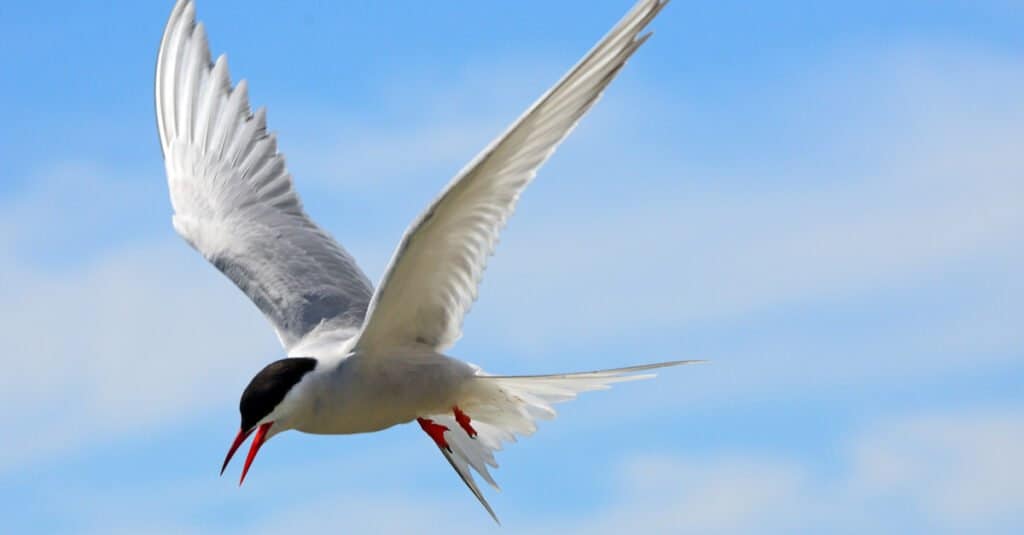
©Attila JANDI/Shutterstock.com
A seabird or gull known as the Arctic tern (Sterna paradisaea) makes the longest migration of any animal – nearly from the top of our planet to the bottom of it. An Arctic tern may fly more than 44,000 miles (71,000 km) per year as it travels from Greenland to Antarctica and back. If a tern reaches its maximum lifespan of 30 years, it will have flown nearly 1.5 million miles (2.4 million km) in migration.
Why does the Arctic tern make this annual trek? Its breeding grounds are in Greenland, and they spend their summers there, raising young. As winter nears in the north, the small birds – weighing only about 4 oz – then travel south to spend the northern winter in the warm season at the bottom of the world.
#9 Incredible Animal Migration: Caribou, the Longest Land Migration
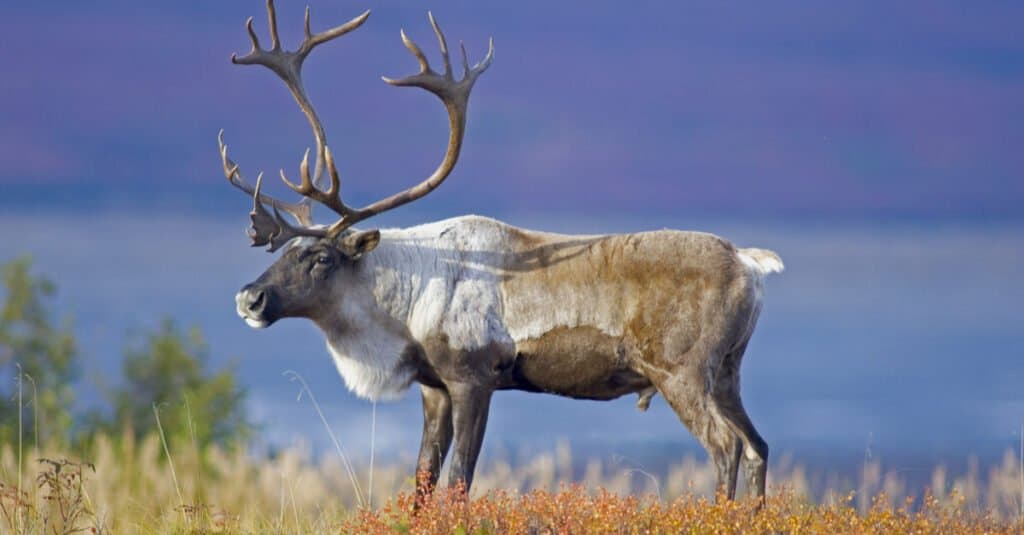
©Jeff McGraw/Shutterstock.com
Caribou or reindeer are deer-like animals. Their annual round-trip migration between their summer and winter feeding grounds is the longest terrestrial or on-land animal migration. How far do caribou travel? Some feeding grounds are 400 miles (640 km) apart. The trek takes about 3 months.
Interestingly, large herds of caribou typically travel farther than smaller herds. Another interesting aspect of this migration is that the caribous’ primary predators – grey wolves – keep pace with the prey animals. That means that the wolves make this great migration, too!
#8 Incredible Animal Migration: Fruit Bats, the Most Numerous Single-Species Migration
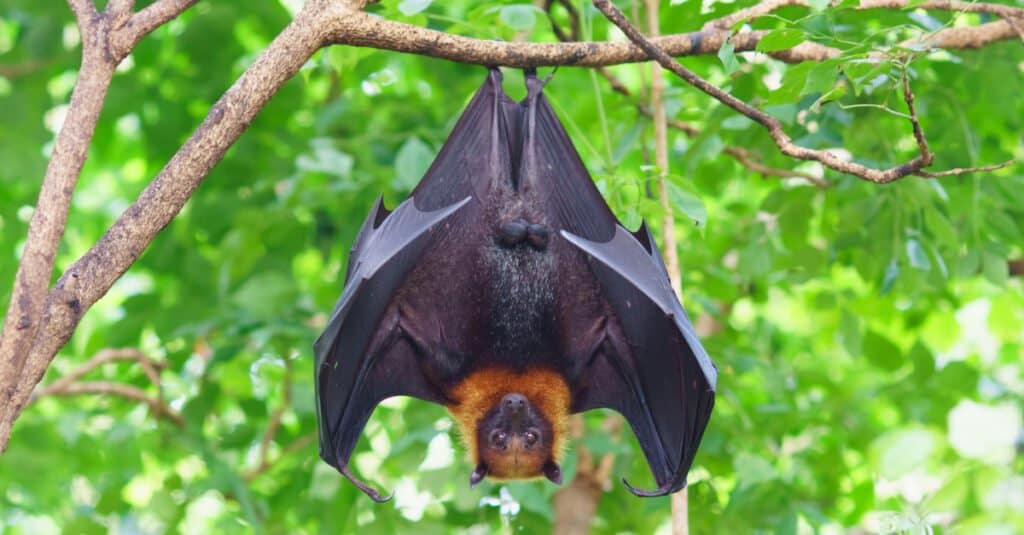
©jekjob/Shutterstock.com
In Northern Zambia lies a small evergreen swamp forest, about the size of three football fields. Each year between the months of October and December, this forest comes alive with more than 10 million fruit bats.
The giant fruit bats or flying foxes travel from the Democratic Republic of Congo in search of mangoes and other fruits with exotic names – red-milkwood berries, water berries, and loquats.
This migration does more than fill the bellies of the bats, however. As they head back home, they excrete the seeds of the fruit they have eaten in their guano. This rejuvenates forests with new growth.
#7 Incredible Animal Migration: Gray Whale, the Longest Mammal Migration
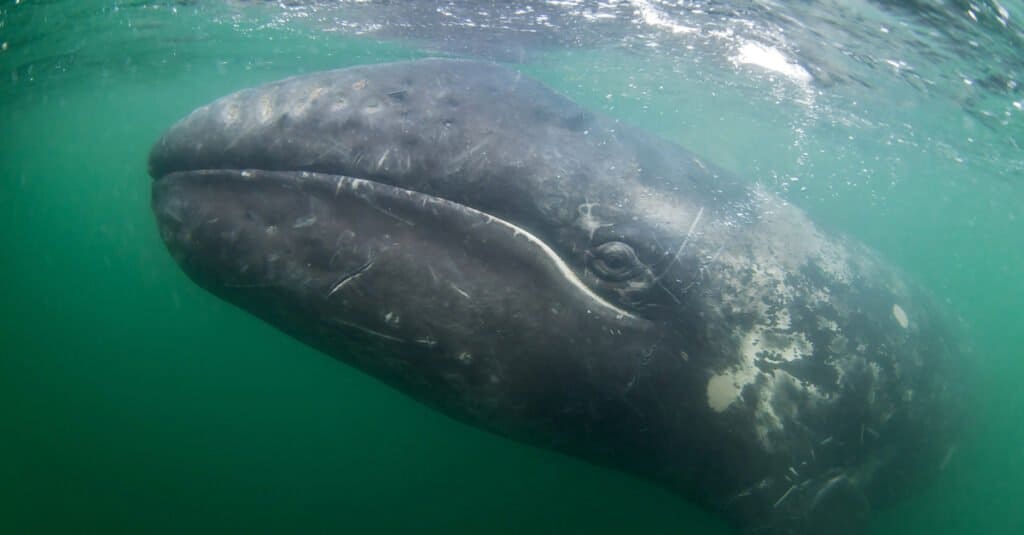
©Alexander Machulskiy/Shutterstock.com
Of all mammal migrations on the planet, the gray whale is responsible for one of the longest, traveling 10,000 miles or more round-trip. Each spring, they migrate north to feed on the abundance of fish in Arctic waters, then return south in the fall to reproduce in warmer waters. Threats they can encounter on their long journeys include being struck by sea vessels or getting tangled in fishing gear.
In 2015, an eastern gray whale set a new migration record – it was tracked as it traveled almost 14,000 miles. The journey began in Russia, took the whale to Mexico, then back home to Eurasian waters. This exceeded a nearly 12,000-mile trip made by a humpback whale in 2011.
#6 Incredible Animal Migration: Salmon, the Most Athletic Migration
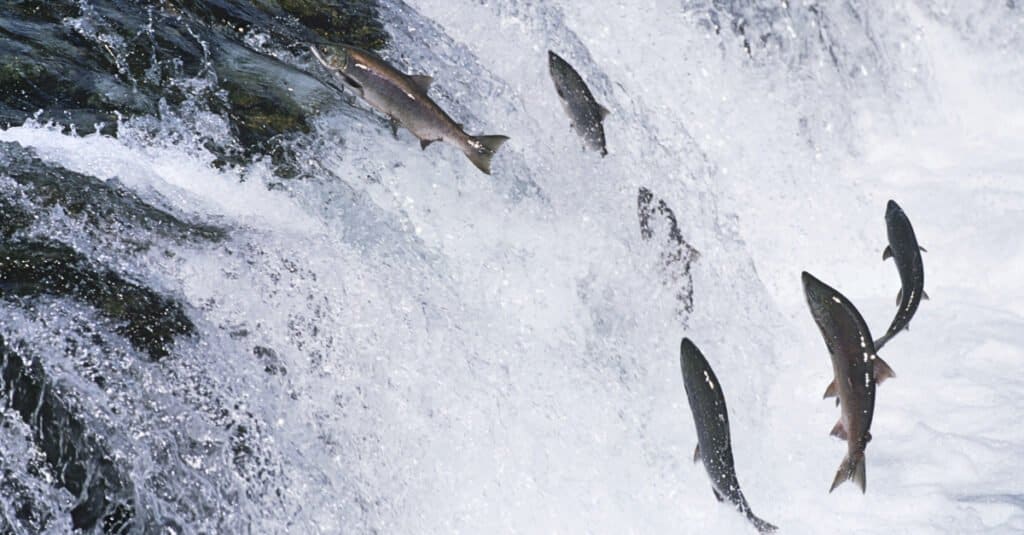
©sirtravelalot/Shutterstock.com
Migrating animals often face many challenges – scarce food or water, inclement weather, or staggering distances. But the salmon (Salmo salar) must overcome literal barriers in order to return to its birthplace.
Salmon spend most of their lives in the open ocean but return to the rivers of their birth in order to spawn. The fish first have to swim upstream, against the current. This requires extreme endurance, as the fish may swim up to 250 miles (400 km) upriver.
Along the journey, the salmon must cross rapids and waterfalls. In order to scale the falls, the salmon leap out of the water. Often, they must try time and again before successfully making it to the top of the falls. Additionally, predators such as bears often wait at these leap-points for mouthfuls of these fish as they migrate as one large group known as a “salmon run.”
#5 Incredible Animal Migration: Humpback Whales, a Fasting Migration
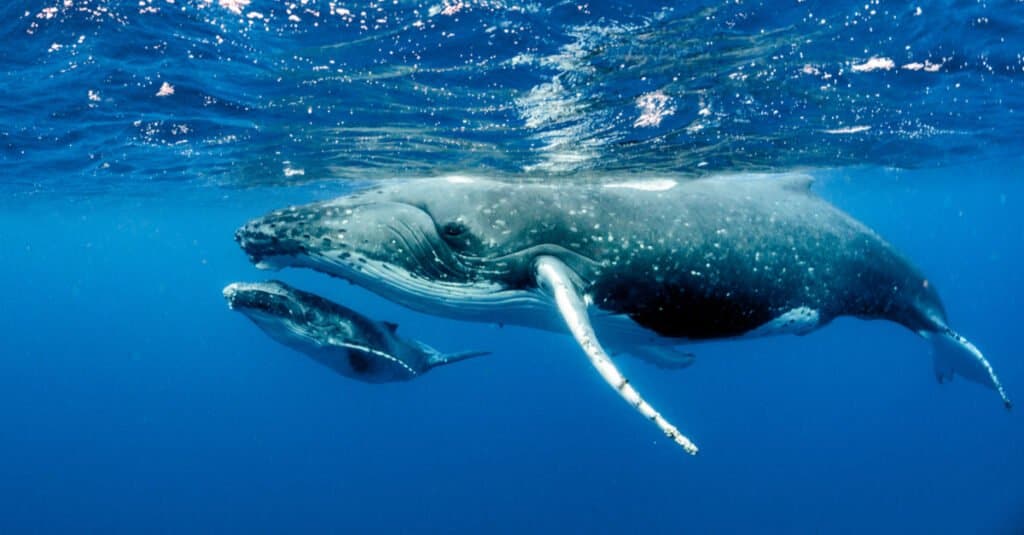
©Imagine Earth Photography/Shutterstock.com
Until recently, the humpback whales‘ migration was considered the longest mammal migration. While the distance of nearly 10,000 miles round-trip has been surpassed by that of the gray whale, humpback migrations are unique for another reason – the adult whales don’t eat for months at a time.
Humpback whales feed on some of the smallest animals – vast schools of tiny shrimp called krill in the waters around Antarctica. But they swim to warmer waters to give birth and raise their young. During this time, the adults do not feed, but they live on fat reserves. When they return to colder waters, they gorge themselves to replenish these stores.
#4 Incredible Animal Migration: Wildebeest, the Most Famous Migration

©Kristof Bellens/Shutterstock.com
Who could forget the iconic scene from Disney’s The Lion King, when a herd of wildebeest stampede through a canyon? This event was based on the real-life migration of the wildebeest, who can run up to speeds of 50 miles per hour and males have horns around 33 inches long! They are mostly found in the two species: blue wildebeest and black wildebeest. It may be no surprise, but the name comes from English and combines the words wild and beast.
These wild bovine-like antelopes participate in perhaps the largest terrestrial migration in terms of sheer numbers. At least 1.5 to 2 million animals congregate and travel up to 1,000 miles per year. Herds of zebras and other antelopes may join them as they roam the Serengeti-Mara of Kenya and Tanzania in search of food and water. Baby wildebeest born along the way are able to take up the journey just minutes after birth.
#3 Incredible Animal Migration: Flamingos’ Irregular Migrations

©Ondrej Prosicky/Shutterstock.com
Flamingos are not generally considered migratory birds. Africa‘s lesser flamingos, however, infrequently make an amazing trek.
Torrential rains can revive a salt pan – the dry bed of an ancient lake – along with the dormant algae it once supported. “Triggered by some unknown signal,” as documentary narrator David Attenborough once described it, the lesser flamingos flock to the lake from thousands of miles away. These conditions only occur about once every 10 years.
The flamingos feed on the algae, breed, and lay eggs on an island. By the time the chicks hatch, the water in the birds’ breeding ground has largely dried up. They need fresh water to drink, so they must travel. The chicks, guided by their parents, must make a different type of migration – on land and on foot, for distances of up to 30 miles (50 km). The young skitter along the ground in a long line in a trip that may last for days.
#2 Incredible Animal Migration: Monarch Butterflies’ Multigenerational Migration
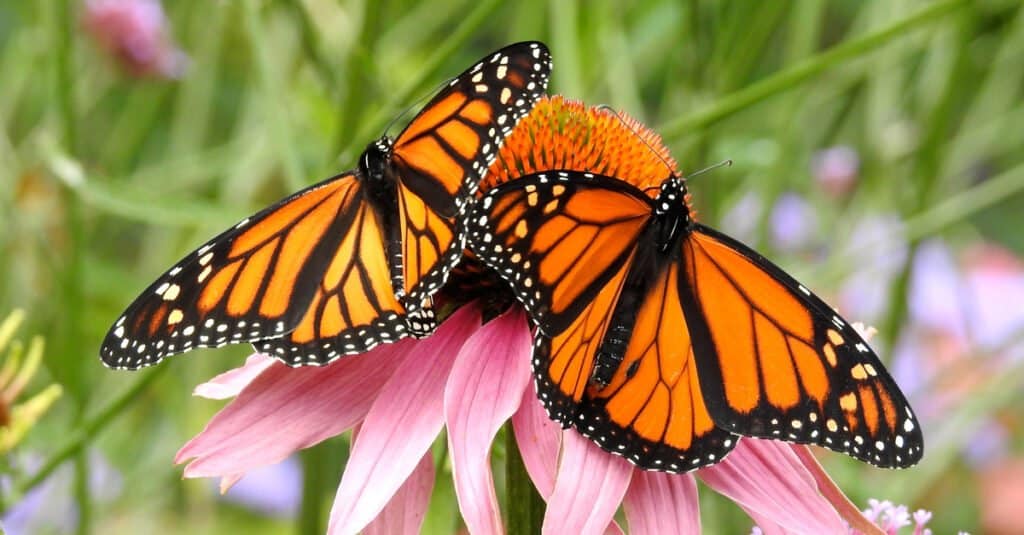
©Kate Besler/Shutterstock.com
Delicate butterflies may not be the type of animal you recognize as a migrant. But monarch butterflies (Danaus plexippus) make an epic journey each year that involves more than one generation of insects.
Millions of monarch butterflies leave northeastern North America as the weather begins to cool. Their destination is the warm forests of Mexico. While migrating, butterflies may travel up to 250 miles per day. The entire journey is about 3,000 miles (4,800 km).
The butterflies then congregate in fir forests, dangling from the trees and each other. The millions of butterflies create a stunning sight.
What makes this animal migration unique is that the round-trip – Canada to Mexico and back to Canada – takes longer than the butterflies’ maximum lifespan. The migrating butterflies are actually made up of three to five generations; along the way, female butterflies lay eggs on milkweed plants. The eggs hatch, the caterpillars eat, and then the mature butterflies continue on the trip started by their parents and grandparents.
Scientists still don’t know exactly how the butterflies know where to go, especially those who are born on the way. They might navigate using the position of the sun or the Earth’s magnetic field.
#1 Incredible Animal Migration: Diel Vertical Migration, the Largest and Most Frequent Migration on the Planet

©Rattiya Thongdumhyu/Shutterstock.com
The world’s largest animal migrations occur not yearly or at irregular intervals, but every single day. Both prey and predatory animals that live in the cold, lightless ocean depths begin to rise at sunset. Creatures making the migration include squid, lanternfish, shrimp-like crustaceans, jellyfish, and many creatures too small to be observed with the naked eye.
What is the distance of this amazing migration? The animals rise hundreds of meters. That might not sound like much, but 300 to 1,000 feet is a huge distance for microscopic animals and those small enough to fit in the palm of your hand.
Why do they migrate? There is little food available in the deep ocean, but the sunlit waters near the surface are home to plankton, krill, and many other food sources. Thus, the deep-sea animals rise to the surface to feed at night.
As the sun begins to rise, the migratory sea creatures sink once again. The dark water below the level that sunlight can reach keeps them safe from visual hunters such as sea birds, salmon, and tuna.
Summary of 10 Incredible Migratory Animals
Here’s a review of 10 animals that migrate with key facts about their behaviors:
| Rank | Animal | Migratory Fact |
|---|---|---|
| 1 | Diel Vertical Migration | Largest migration from the depths of the ocean |
| 2 | Monarch Butterfly | Migration takes longer than the average life span |
| 3 | Flamingo | Will travel thousands of miles when their preferred salt-pan grounds are flooded |
| 4 | Wildebeest | At least 1.5 to 2 million animals congregate and travel up to 1,000 miles per year |
| 5 | Humpback Whale | Will travel nearly 10,000 miles while fasting |
| 6 | Salmon | The most athletic migration |
| 7 | Gray Whale | It was tracked as it traveled almost 14,000 miles |
| 8 | Fruit Bat | Over 10 million fruit bats migrate every winter |
| 9 | Caribou | Will migrate over 400 miles for new feeding grounds |
| 10 | Arctic Tern | An Arctic tern may fly more than 44,000 miles (71,000 km) per year |
Up Next…
- Top 10 Wild Dog Breeds in the World Wolves, foxes, coyotes, jackals…these are just some of the wild dog breeds that roam our planet. Find out the top 10 in this fascinating read.
- The 15 Laziest Animals in The World Some animals are just so lazy, it’s a wonder they have survived in the wild. Here’s a look at the 15 laziest animals, and some may surprise you!
- The 10 Fastest Fish in the Ocean Join us as we explore the Deep in search of the fish that exhibit record-breaking speeds.
- Where Do Geese Go in the Winter?
The photo featured at the top of this post is © Kate Besler/Shutterstock.com
Thank you for reading! Have some feedback for us? Contact the AZ Animals editorial team.






